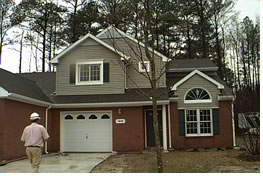
Army Engineer Research and Development Center
U.S. Army Corps of Engineers
Architects doing business with the U.S. Army can expect to see new selection criteria for all project types: experience in sustainable design and development (SDD). Far from being a passing fad, SDD for military construction projects is here now—and it's here to stay.
 The
Department of the Army has issued a policy to create Sustainable Army
Communities in an effort to improve the quality of life for its personnel
while considering environmental and energy concerns. The working definition
of SDD is "the design, construction, operation, and reuse/removal
of the built environment in an environmentally and energy-efficient manner."
The
Department of the Army has issued a policy to create Sustainable Army
Communities in an effort to improve the quality of life for its personnel
while considering environmental and energy concerns. The working definition
of SDD is "the design, construction, operation, and reuse/removal
of the built environment in an environmentally and energy-efficient manner."
The assistant chief of staff for Installation Management and U.S. Army Corps of Engineers (USACE) together are taking specific actions to include SDD in military installation master plans and infrastructure projects. The intent is to integrate SDD principles into all actions and decisions that have an impact on Army installations while taking into account user requirements and funding constraints.
Sustainable design
in all phases of the process
The Army process is to infuse SDD at each phase of decision making: infrastructure
life-cycle planning, programming, design, contracting, construction, operation,
maintenance, renovation, and disposal.
What that means for A/E providers in practical terms
can be seen in the proposed USACE language for the selection/evaluation
criteria section of its solicitations, which calls for specialized experience
and technical competence in:
• Sustainable design using an integrated design approach and emphasizing
environmental stewardship, especially energy and water conservation and
efficiency
• Use of recovered and recycled materials
• Waste reduction
• Reduction or elimination of toxic and harmful substances in facilities
construction and operation
• Efficiency in resource and materials utilization and development
of healthy, safe, and productive work environments.
The evaluation will consider projects performed by the prime firm and consultants that demonstrate these sustainable design principles, as well as qualifications of key personnel that demonstrate their experience and training in sustainable design.
Catch the SPiRiT
Many A/Es are already familiar with rating processes that help show, at
the planning stages, how "green" a building will be. Based on
similar concepts, the Corps of Engineers' district offices are training
to use a new procedure called Sustainable Project Rating Tool (SPiRiT)
to help achieve the Army's sustainable design and development goals. Developed
by the Army Engineer Research and Development Center (ERDC), SPiRiT is
the military version of the U.S. Green Building Council tool, "Leadership
in Energy and Environmental Design"(LEED™ 2.0).
SPiRiT gives an easy-to-use rating method to the Corp's districts, which are responsible for regional military construction and civil works projects. During the charette phase, it allows project delivery teams to score various design features that define how sustainable a building will be over its life cycle. A project is rated for sustainability using four levels of achievement: bronze, silver, gold, and platinum. Current Army policy is for designs to achieve at least a bronze rating.
SPiRiT version 1.4 is a Word-formatted document with point summary sheets in Excel. This makes it easy to print and use the checklist while enabling an automated tally of point scoring results. You can download SPiRiT free.
ERDC is working with the Green Buildings Council to develop next-generation LEED™ tools that incorporate military-unique requirements. The Army will continue to use SPiRiT until LEED™ 3.0 is released, tentatively scheduled for 2006. The Green Buildings Council offers LEED training courses to the private sector. In addition, a continuing-education course, "Understanding and Using the Sustainable Project Rating Tool (SPiRiT)," will be presented at the 2002 AIA national convention in Charlotte (currently slated for May 11, 2:00–3:30 p.m.). USACE representatives will conduct the course.
Should your firm
get involved?
Should A/E firms invest in SDD training? In terms of the outlook for the
U.S. military construction program, consider that:
• The Army is in the middle of a major transformation toward a force
that may be radically different from the current one, creating requirements
for new supporting infrastructure
• Army leadership continues to emphasize and promote privatization
of existing and future facilities
• Some 50 million square feet of excess buildings are slated for
demolition
• The prospect of more base closings is still high, with opportunities
for more demolition and redevelopment.
Copyright 2001 The American Institute of Architects. All rights reserved.
![]()
|
To learn more about the Army's SDD initiatives, visit a Web site maintained by the ERDC Construction Engineering Research Laboratory (CERL), or contact Harry Goradia , HQ USACE, 202-761-7170, or Richard Schneider or Annette Stumpf, CERL, 217-373-6752 or 800-USA-CERL, ext. 7542. Family housing like this unit at Fort Lee, Va., incorporates sustainable design principles—and typically has a waiting list for residents. Courtesy of the USACE |
|